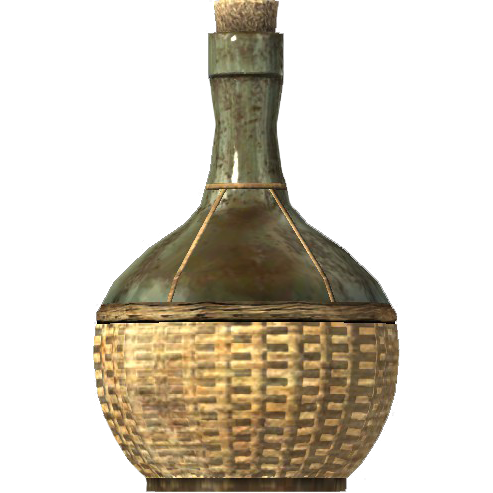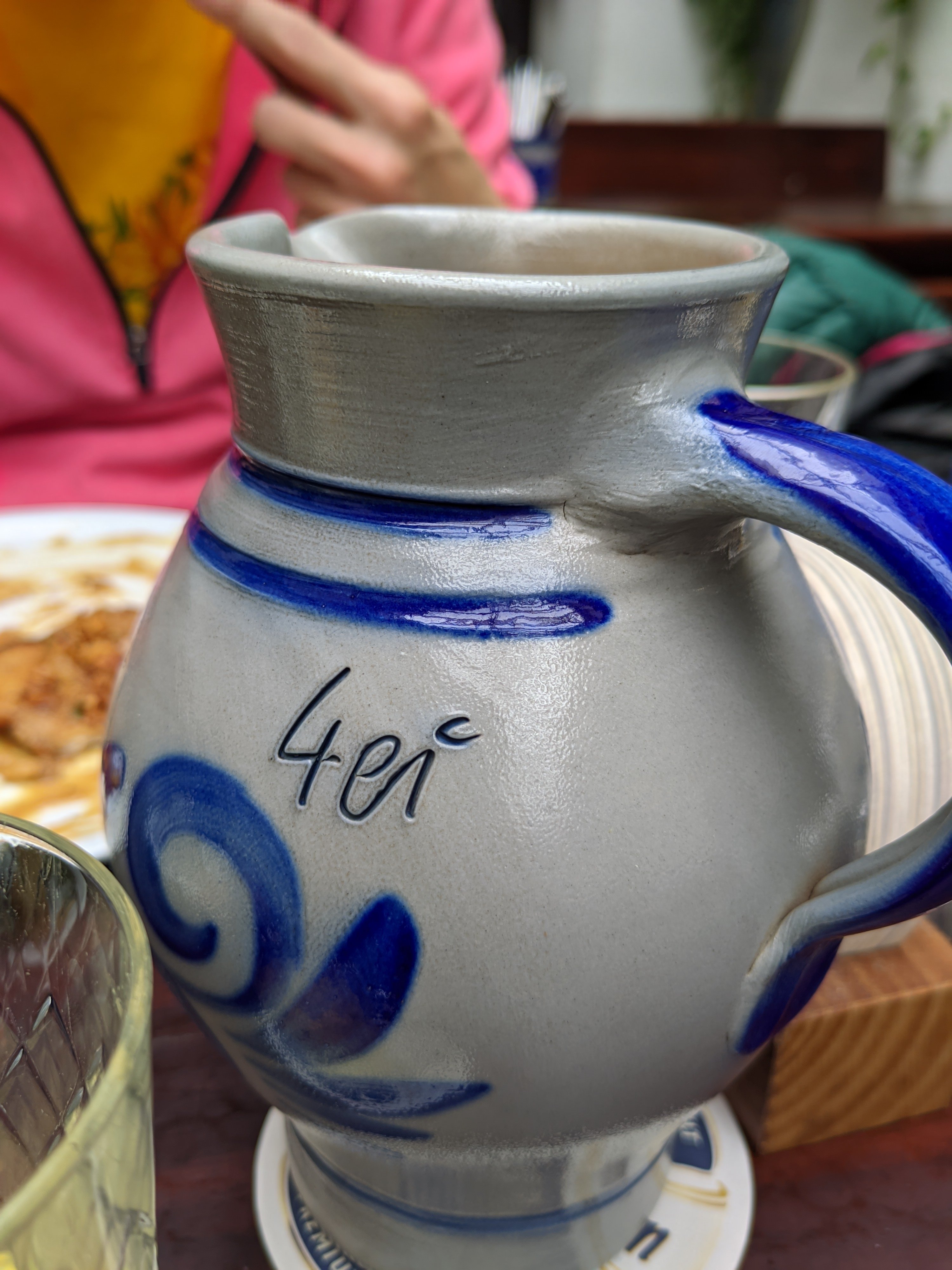What would have been a liberal estimate of the possible alcohol ABA or %? How much sugar would have been in it/L?
Even wine for Kings?
Fun fact: Jacques Cousteau and his team once discovered a shipwreck with some intact jugs of 2000-year-old Roman wine. For whatever reason, they broke one open and drank some of it. They said it wasn’t all that tasty at that point.
Except, after they had their party and were working on recovering the rest of the wreck, they realized that the intact one they’d found right at the beginning was the only one that had been intact. Literally the singular one. They searched extensively to try to find another, and couldn’t.
Oops.
I dunno. Someone’s gotta experience drinking the wine, might as well be the ones who found it
I mean they could have had it analyzed, probably found out some pretty fascinating things about Roman wine, and then if they wanted to drink it after before it went bad, maybe they could just save some out when they were delivering it for study. Or they could have sold the thing to finance a whole other expedition probably.
I get it. You can’t live your life just saving it all in the right file folders. At the same time…
My neighbour buys grapes, presses them (not trampling), and puts them into demijohns with an airlock. He adds nothing. It ferments using yeast on the grapes over several months. Over the course of a year, he decants from one demijohn to the next, which clarifies yeast, then he bottles and lets it rest some more. It’s in a cool part of the house, about 14-18C.
It’s very tasty wine, but doesn’t have any oak overtones or adjuncts (whether lead or vanillin or whatever else is added), it’s not blended, and it’s moderate abv (around 10%).
This process requires very little in terms of specific materials other than the glass instead of clay. Clay vessels, being porous, would alter the flavour and would harbour yeasties and other microorganisms. But even accounting for that, I don’t think there’s any basis to say ancient wine would be dogshit. It may be different, accounting for taste, but not bad. (Consider the popularity of sour beers (kettle sours or otherwise) and hazy beers. Both of those were considered highly undesirable properties of beer for most of the 20th century - so tastes change. )
The process seems simple but I made my own wild plum wine last year and just leaving it to ferment for 3 days too long almost turned it into vinegar. Also for anyone else wanting to try it, unless you’re using something with skin like grapes or plums you need to add your own tannin.
Standard saccharomyces will ferment all the simple sugars, unless interrupted. Some fruit don’t have much in the way of complex sugars (which are responsible for rounding out flavour), and some fruit just don’t have a pleasant flavour without sugar present. It’s also possible that there’s a Brett or other bug in there that ferments the less simple sugars and brings it down stupidly dry. I think plums are on the stupid dry list; I’ve had them in a sour beer and it was… crushingly tart.
Clay vessels, being porous, would alter the flavour and would harbour yeasties and other microorganisms.
There’s a winery in Sonoma called the “Jacuzzi Family Vineyards” (yes, that Jacuzzi) that does fermenting in amphora jars for their Clarum. It is just about my favorite wine. Very light and minerally, perfect for a hot day. At $50/btl, its not cheap. But I like to set aside a bottle or two for special events.
If ancient wine is anything like that, they’ve got nothing to complain about.
Congratulations, you just sold two bottles of wine. Do I need to use a referral code?
Jokes aside this looks amazing. One of the best wines I’ve ever tasted is called TALEiA, by Castell d’Encus out of Spain. It is exactly as you describe — refreshing, light, with a mineral note because they age it part of the time in these ancient granite basins. It has a trembling newness with a brave young heart underneath, simply magical.
Congratulations, you just sold two bottles of wine. Do I need to use a referral code?
Damn. Should have considered negotiating that in advance.
One of the best wines I’ve ever tasted is called TALEiA, by Castell d’Encus out of Spain.
Turnabout is fair play. I suppose I should order a bottle or two myself.
I’ve made wine (and a lot of beer). It’s not hard, and people have been doing it for ages, but creating a good, consistent product does rely on chemistry/biology knowledge that they wouldn’t have had back then.
I suspect that a lot of the mystique around wine (like the idea that terroir is magic) is just down to the fact that a few hundred years ago, most wine/beer was trash, and the only stuff we’d consider “good” by modern standards is just down to luck that a batch didn’t get infected with the wrong yeast/bacteria, or exposed to too much oxygen, or a style that is meant to be drunk young (vinho verde) or oxidized (sherry).
There’s probably good reason that much of the wine that was aged/transported long distance a couple hundred years ago was fortified (Madeira, Port, sherry, vermouth, etc.).
Millenia of selective breeding have changed grapes, too. Without knowing for certain, my guess would be that on average, the sugar concentration in the raw grape juice would be roughly the same as now, but relying on wild yeasts or polycultures would not ferment as completely, so the final product would have lower ABV and higher sugar.
In beer, the actual grain and malting technology has greatly changed over time. 150 years ago, German immigrants to America couldn’t brew the lighter styles they were used to because American grain was much higher in protein so they had to dilute it with corn/rice. Older grain had a higher propensity for certain defects, too. Basically you had more inconsistency back in the day, and also just some things that were different.
Go back in time and give an ancient king some boxed wine and be given 500 sheckles, 3 goats, and a concubine.
Or just take a 5kg bag of refined sugar to buy a whole ass estate with slaves
- how was it fortified?
“Fortified” means that liquor is added which acts as a preservative and it also stops further fermentation so you can have more sugar left in the wine. Oftentimes, herbs are added, too, which also acts a preservative.
In beer, IPAs are similar in that greater amounts of hops were added so it could survive the trip to India with less chance of spoiling.
Do you know when the first liquors were discovered or stumbled on? Did they have it back then in ancient times?
I think full modern-strength liquor is relatively new-ish (500-1000 years). I’m just thinking back to the meme of the wikipedia article on the “timeline of Irish inventions” that has the invention of whiskey and then a gap of 300 years before they invented anything else.
Star forts
I dont know wat that meenz
It’s a fortification
Likely, and it also may have contained lead.
Dogshit? No. Different? Definitely. The wild yeasts on the skin weren’t cultivated for alcohol tolerance, so ancient wines would tend to have a lower ABV. They might have some sourness from bacteria found on the skin along with the yeast. Whether or not they’d be sweet or dry would depend on the yeasts and the grapes themselves. There would be a lot of variability from year to year. The Romans, for one, preferred sweeter wines and would add grape syrup, defrutum, made from boiling down grape juice, if the wine was dry. Other cultures might do something similar or just grin and bear it. There was a lot of variety across time and place.
It should be noted that the Romans would sometimes use lead vessels for making defrutum. This would add lead acetate to the syrup, which has a sweet taste, and make it even sweeter.
I don’t know if I’d say “bad” but certainly different.
Today we have catalogs of different strains of yeast one can order to ferment beverages. Prior to that, people would just be leaving the liquid open to the air to pick up wild yeasts. Whether that led to something good or bad was a bit up to chance.
Same with the resulting ABV. Different yeasts will thrive to different alcohol levels. My first experiment making wine was with bread yeast I had on hand. It worked, and the wine was a hit with all who sampled it, but it was lower in alcohol and higher in residual sugar because that yeast has been cultivated for bread, not alcohol. The same starting juice with a modern dry red wine yeast results in just that.
Also some wines like sherry are made by doing things like heat cycling and introducing oxygen that are “bad” for typical wines.
During different periods, sweet wine was in fashion, so we can’t really use that as a basis of quality, it’s just the choice of the winemaker.
Wine was also made out of a wider variety of ingredients than with most commercial stuff today, so there are probably awesome herbal infused drinks lost to time or things that are still just regional items that most of us have never heard of.
As a big part of culture, our beverages will continue to evolve, and while some may prefer more of what we consider classic wines now may not hold true in the future. What we have today is just built in centuries of experimentation, which for me, is the fun and rewarding part of brewing.
You can buy wild-fermented wines today as well, although you’ll usually have to go to a fairly good specialist shop for it in my experience. They’ve got a very distinct but interesting and pleasant sourness, much like sourdough bread. I imagine that all of the other changes and improvements in processes and ingredients still means it’s very different to ancient wine, but it’s potentially a good way to get an idea for what that aspect of it can do
I’ve had some wild beers, but I don’t know if I’ve had wild wine. Sourdough is a good comparison, because those are the same wild yeasts you’d get for brewing that you’d get if you made your own starter.
If you like wild beer and regular wine, you’ll probably enjoy wild wine too! Or at least, I do. I just wish it was more readily available near me, particularly since I am somewhat afraid of brewing it myself
I think you should try it! Most of what I’ve done has been more for for r/prisonhooch than r/winemaking and it’s all been ok to pretty darn good.
Get a hydrometer and some brewery wash and 2 jugs that fit an airlock and stopper. I’ve done almost all my fermenting in used juice jugs.
I never found it harder than making bread. There’s no kneading, but I usually make a bigger mess transferring liquids, so it is messier. It’s fun though, and very little hands on time. Make small batches and there’s very little financial risk. Once you get the hang of it, then invest in some carboys and whatever other fancy things you desire.
If your worried about growing something unintended, do a few with purchased yeast so you can learn how the normal year reaction and the byproduct looks and smells at various stages so when you “go wild” you know what’s normal. It does sometimes burp some foul gas depending on the strain of yeast. I forget what gas it is, but it’s normal, some yeasts just have stinker gas. 😁
Oh I’ve made plenty of beer (and fruit wine, and gin, and currently an attempt at bochet that is awaiting bottling)! It really is just the wild yeast I’m afraid of
I figure I could probably do enough reading and learning to make myself comfortable, but there are enough other things I want to make that I’m not prioritising it just now. I had a crack at a pomegranate and date wine over the winter that I particularly want to improve
Oh, very cool! I’ve only done random wines, and I did distilling once. Pomegranate and date sounds really good!
The theory was to get the proportions right to replicate the pH, sugar content, and tannins close to grape must without having to add much else. Turns out, by chance, that on those three factors, pomegranate and dates are all roughly different from grapes in opposite directions and amounts to each other.
I live in Scotland, which is not exactly prime pomegranate and date territory, so they’re both kinda expensive here and not great quality out of season. I did a trial run with pomgranate molasses to just see if I was on to something without spending as much money (or having to crack open and juice like twenty pomegranates)
If I figure out an actual good recipe I’ll be sure to stick it on [email protected]
I worked with a guy who graduated with a history degree. l remember talking about wine and what it might have been like before modern times.
His main point was that people in ancient times would think we’re lush fools. Nobody would drink pure wine. It would have been watered down. Also the majority of modern wine is aged in oak barrels that usually get used for bourbon before being used for wine. so ancient people wouldn’t recognize the modern wine
That’s not true. The majority of wine is aged in standard oak barrels. Bourbon barrel-aged wine is a modern gimmick which is not at all common in the classic wine growing regions.
Toldinstone (classical history youtuber) has a great video on ancient Roman wine that talks about this: https://youtube.com/watch?v=4rhT7EkTgu0
Thanks
I bet our wine is MUCH sweeter to compensate for our sugar tolerance.
How so? The ancients literally added lead sugar to wine because they wanted it sweeter.
If anything, I’d suspect modern winemaking techniques make it easier to produce dry wines that are palatable.
We consume more sugar daily than they did.
I think we require more sugar to obtain the same perceived level of sweetness, but that’s just a theory.
Is it hard to actually have low sugar dry wine?
No. Lots of sweet wines are fermented until dry. Then they add potassium metabisulfite to kill the yeast, then “back sweeten” the wine by adding sugar once the yeast is dead.
They didn’t do that.
They just used high sugar grapes like gordo blanco, the yeast would go dormant once the alcohol content had got to about 14% and there would still be lots of sugar left.
Now they ferment up to the level of alcohol they want, then refrigerate the must, which makes the yeast go dormant and form hard shells so it can be filtered and centrifuged out.
If you killed the yeast while still active, the cells will rupture and the wine will taste like marmite.
It was common in the new world to create “sweet wines” by adding pure alcohol to the must, which would cause the yeast to become dormant, and then filter it out. This was how “white port” was made. Since the invention of refrigerated brine jackets, this method has been abandoned.
Interesting to know about the white port process as we’ve drank a bottle of that recently for the first time.
Your knowledge is beyond mine on the subject. I mostly made various country wines, usually just a half gallon or gallon at a time to experiment with yeasts and to practice balancing.
That’s why I think it’s probably unfair to think ancient brewers made crap. I mean, like any business, I’m sure some did, but if they were taking food to make it, it had to be worth it for most of history, and it doesn’t take a lot of high tech stuff to make a palatable drink.
Low ABV drinks have kept people safe and happy for a long time, and I feel a majority of those people at least tried to be artisans like any other tradesman. Consistency and storage was probably the biggest difference, especially before the hydrometer, but with basic cleanliness and a few brews under your belt, I think someone in the day could have made something decent with nothing else.
Such a waste of perfectly good wine :/
Back sweetening doesn’t have to be to make it super sweet. Sometimes wine will ferment very dry and is beyond as dry as what you wanted. Other than adding straight sugar, more unfermented juice can also be added to enhance the flavor to either just make it sweeter or to add some of the non-fermented flavor back in that is lost. You can also have wine that produced a higher ABV than was desired, and adding water or juice can dilute it down.
Blending and balancing wine is really the hard part of making wine, especially if you’re after a consistent product. Different pieces of fruit have different sugar levels and different yeast does more or less than you intend it to do, so the good wine makers can nudge that end product into what they actually wanted without ruining it.
Champagne is made by using low sugar grapes, fermenting until there is no residual sugar, and then ageing in barrels.
All the sweetness in Champagne is artificial, its made by adding sugar syrup to the bottle before the secondary fermentation used to create the bubbles.
I wonder if Tropicana was based on this with their “flavor paks”
That sounds like the same principle to me. They need it to taste fresh and orangey and just like last year’s Tropicana even if it was the best or worst year ever for growing oranges or customers are gonna be upset. Can’t buy from one farm this year and need to buy from one in a totally different place where the oranges might be another variety or just have a different flavor from different soil? Give it a nudge back toward that brand flavor profile. That consistency is what people like about name brands especially.

Restore 15 points of Stamina, Stamina regenerates slower by 30% for 30 seconds.
You just inspired my newest quest(ion), well done
I imagine because wild yeast strains are far less alcohol tolerant that you’d end up with something more akin to a lambic, especially if they don’t filter it.
The 1287 Chateau de’Champignon has a lot of flavor, you can really taste the feet.
Yes.
I think I heard once that Romans mixed wine with salted water. So taht could be a bit of an aquired taste. Or a banger alcoholic soy sauce…
I know there was a more common everyday wine with pretty low alcohol content and not much to any sweetness. Alcohol was a good way to ensure clean drinking water and naturally keeps out a lot of bad bacteria. That’s why drinking wine is way more common in the Bible AFAIK
also notice that it’s also about things like electrolytes and vitamines
whether you eat raw fruit or drink fermented fruit juice probably doesn’t change these properties, but additionally you get a light drug which is a positive side effect (to the people) so i guess that’s why they fermented whatever fruits they had
also it’s durable throughout the winter or sth
















